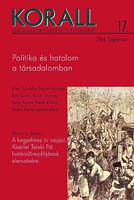Nagypolitika kicsiben: parlamenti választás és társadalmi háttere Zalaegerszegen 1935-ben
Grand Politics from a Small Perspective: the 1935 Parliamentary Elections and their Background in Zalaegerszeg
Author(s): Zoltán PaksySubject(s): History
Published by: KORALL Társadalomtörténeti Egyesület
Keywords: social history; Hungary; 20th century; 1935 parliamentary elections; local elite; Zalaegerszeg
Summary/Abstract: The study provides insight into the political conditions of Hungary between the two world wars through the examination of the general elections in a small rural town. Three parties entered the election race: the authoritarian, conservative party that had governed the country since 1920, and whose leader, Gyula Gömbös intended to convert into a movement party with a broad social basis, primarily according to the existing Italian example. The two other parties belonged to the opposition, but their political directions were substantially different. The candidate of the Catholic Christian party proclaimed the revival of the political system of the pre-World War I liberal Habsburg Monarchy. Opposing this, the candidate of the radical, extreme right Arrowcross movement was a follower of the German Nazi party. Analysis of the voted indicates that there is a correlation between the votes cast for the different parties and the existence of certain social groups. Thus, the governing party was primarily supported by the population of the town, especially by officials and intellectuals. As the ballot was open, we presume that the choice of those voters who had a stable livelihood was motivated by their loyalty to the powers that be. It is a special point of interest that the majority of Israelite voters within the local electorate also cast their votes in favor of this party. We cannot do better than to assume that the reason for this was that they were reassured by county Lord Lieutenant’s firm stance against the Arrowcross movement. The supporter base of the loyalist candidate was the most heterogeneous of the three, containing members of all different social groups of the local electorate in equal proportions. As opposed to this, the voter-base of the Arrowcross Party was the most homogenous: their candidate was almost exclusively supported by the peasants of the villages around the town. This trend indicates that a part of the Hungarian peasantry had enough of the hopelessness of its situation and was willing to support a radical movement that offered demagogic promises to swiftly better its prospects.
Journal: Korall - Társadalomtörténeti folyóirat
- Issue Year: 2004
- Issue No: 17
- Page Range: 88-106
- Page Count: 19

